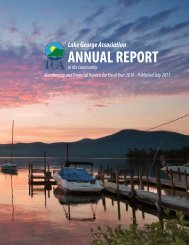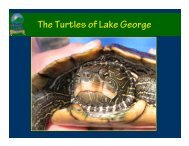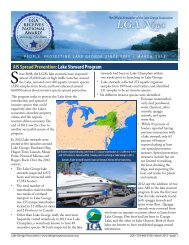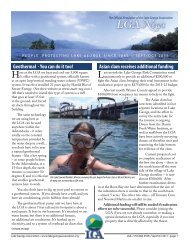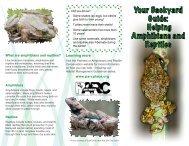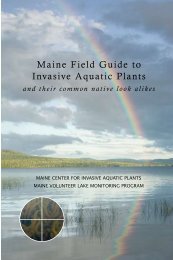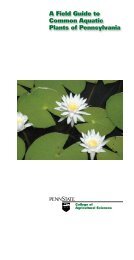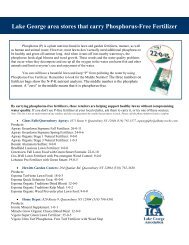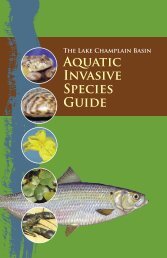Invasive Plants of the Adirondacks - Adirondack Park Invasive Plant ...
Invasive Plants of the Adirondacks - Adirondack Park Invasive Plant ...
Invasive Plants of the Adirondacks - Adirondack Park Invasive Plant ...
You also want an ePaper? Increase the reach of your titles
YUMPU automatically turns print PDFs into web optimized ePapers that Google loves.
APIPP<br />
c/o The Nature Conservancy – <strong>Adirondack</strong> Chapter<br />
P.O. Box 65, Keene Valley, NY 12943<br />
518-576-2082<br />
www.adkinvasives.com<br />
ADIRONDACK PARK<br />
INVASIVE PLANT<br />
PROGRAM<br />
MAKE A DIFFERENCE<br />
GET INVOLVED<br />
More than 30 nonnative invasive plant species<br />
have crept into <strong>the</strong> <strong><strong>Adirondack</strong>s</strong>, including<br />
shrubby honeysuckles, common and glossy<br />
buckthorns, spotted knapweed and o<strong>the</strong>rs.<br />
They degrade important travel corridors, like<br />
New York State Byways, and are extremely<br />
costly to control. They put at risk our scenic,<br />
natural, and recreational resources – linchpins<br />
to <strong>the</strong> region’s economic livelihood.<br />
You can help protect our valuable resources<br />
by learning how to identify harmful plants in<br />
your community, spreading <strong>the</strong> word about<br />
<strong>the</strong>ir negative impacts, and joining <strong>the</strong> regional<br />
effort to put a stop to <strong>the</strong> growing threat<br />
invasive plants pose to <strong>the</strong> <strong><strong>Adirondack</strong>s</strong>.<br />
INVASIVE PLANTS<br />
OF THE ADIRONDACKS<br />
ADDITIONAL INFORMATION<br />
tncweeds.ucdavis.edu • ipane.org<br />
ipcnys.org • lcbp.org<br />
i<br />
rond a c<br />
k<br />
Pa<br />
Ad<br />
r<br />
k<br />
CREDITS<br />
Funding for <strong>the</strong> design and printing <strong>of</strong> this brochure was managed by<br />
<strong>the</strong> <strong>Adirondack</strong> North Country Association and provided by <strong>the</strong> New<br />
York State Department <strong>of</strong> Transportation’s Scenic Byways Program<br />
through <strong>the</strong> Federal Highway Administration and TEA-21 Program. For<br />
additional scenic byway information, visit www.adirondack.org.<br />
<strong>Adirondack</strong> Trail<br />
Scenic Byway<br />
Olympic<br />
Scenic Byway<br />
sINCE 1998<br />
INva<br />
s<br />
iv<br />
e<br />
APIPP<br />
P<br />
la nt<br />
Progra m<br />
Protecting <strong>the</strong> <strong>Adirondack</strong> <strong>Park</strong> from <strong>the</strong><br />
negative impacts <strong>of</strong> nonnative invasive plants.<br />
WWW.ADKINVASIVES.COM
WHAT ARE<br />
INVASIVE PLANTS?<br />
Nonnative invasive species are plants, animals,<br />
and o<strong>the</strong>r organisms ei<strong>the</strong>r accidentally or<br />
intentionally introduced from o<strong>the</strong>r places. In<br />
recent years, <strong>the</strong> rate and risks <strong>of</strong> invasive species<br />
introductions have increased due to human<br />
population growth, movement <strong>of</strong> people and<br />
materials, and environmental alteration.<br />
Once established, invasive species negatively<br />
impact agriculture, industry, recreation, forestry,<br />
human health, and <strong>the</strong> environment. Due to <strong>the</strong><br />
lack <strong>of</strong> natural controls and high reproductive<br />
ability, invasives can quickly become widespread.<br />
<strong>Invasive</strong> plants, in particular, tend to grow faster,<br />
taller, or broader, robbing space, light, and<br />
nutrients from native flora.<br />
<strong>Invasive</strong> species change not only <strong>the</strong> way an area<br />
looks but also <strong>the</strong> way it functions ecologically.<br />
Infestations can disrupt fire regimes, water<br />
absorption and circulation, nutrient cycling, or<br />
even create a toxic environment. They degrade<br />
habitat quality which can reduce <strong>the</strong> number and<br />
variety <strong>of</strong> fish and wildlife. <strong>Invasive</strong> species also<br />
pose risks to human health and safety by<br />
exacerbating allergies and introducing new<br />
diseases.<br />
IDENTIFICATION<br />
When identifying invasive plants, be aware that<br />
<strong>the</strong>y may look similar to native plants. Familiarize<br />
yourself with <strong>the</strong> invasive plants in your area.<br />
Pay close attention to leaves, flowers, and o<strong>the</strong>r<br />
plant structures to help distinguish among species.<br />
MANAGEMENT<br />
Management techniques are different for each<br />
species. By knowing a little bit about each invasive<br />
plant’s biology, you can prevent well-intentioned<br />
control methods from doing more harm than<br />
good. Many aggressive invasives resprout from<br />
tiny roots, stems, or leaf fragments. Be informed<br />
about <strong>the</strong> appropriate control and disposal<br />
methods, and permits needed, before beginning<br />
any management program.<br />
SPREAD PREVENTION<br />
Each <strong>of</strong> us – from boaters to birders, and hikers<br />
to highway personnel – can help to prevent <strong>the</strong><br />
spread <strong>of</strong> invasive species.<br />
START NOW<br />
Learn about invasive plants that are, or have <strong>the</strong><br />
potential to become, especially detrimental to <strong>the</strong><br />
health <strong>of</strong> our public and private lands and<br />
waterways.<br />
APIPP is a coalition <strong>of</strong> organizations and citizens taking<br />
action against invasive species in <strong>the</strong> <strong>Adirondack</strong> <strong>Park</strong>.<br />
NATIVE HISTORICALLY FOUND IN AN AREA<br />
NONNATIVE INTRODUCED FROM SOMEWHERE ELSE<br />
INVASIVE CAUSES MEASURABLE HARM TO<br />
ENVIRONMENT OR ECONOMY<br />
NUISANCE INTERFERES WITH HUMAN ACTIVITY
TERRESTRIAL<br />
INVASIVE PLANTS<br />
Many terrestrial invasive plants were<br />
introduced for ornamental purposes, but<br />
<strong>the</strong>ir expansion into natural areas now puts<br />
at risk <strong>the</strong> value <strong>of</strong> our upland, riparian,<br />
and wetland ecosystems. Infestations can<br />
increase erosion, clog drainages, reduce<br />
forage for wildlife, and alter soil composition.<br />
Best management practices provide<br />
guidelines for effectively and safely<br />
managing invasive species. They include<br />
field-tested control techniques and consider<br />
environmental and regulatory restrictions.<br />
Contact APIPP for best management<br />
practices and safe disposal methods.<br />
QUICK TIPS FOR SPREAD PREVENTION<br />
v Landscape with native, or noninvasive nonnative,<br />
plants.<br />
v Read labels when planting seed mixes; <strong>the</strong>y may<br />
include invasive species.<br />
v Remove invasive plants from your property.<br />
v Never compost terrestrial invasive plants.<br />
v Clean tread and tires <strong>of</strong> vehicles, gear, and equipment.<br />
v Avoid picking roadside wildflowers, which may transport<br />
seeds.<br />
v Know your source: use weed-free seed, mulch, topsoil,<br />
and fill.<br />
JAPANESE KNOTWEED<br />
Fallopia japonica ORIGIN: Asia<br />
DESCRIPTION Japanese knotweed is a fast-growing,<br />
herbaceous perennial with jointed, hollow stems and<br />
alternate, lea<strong>the</strong>ry leaves that are broadly ovate. A cascade<br />
<strong>of</strong> white flowers blooms in August, and dormant reddish<br />
stems are visible in winter. Giant knotweed, Fallopia<br />
sachalinensis, is ano<strong>the</strong>r nonnative knotweed in <strong>the</strong> <strong>Park</strong>.<br />
HABITAT Japanese knotweed is found along forest edges<br />
and stream banks, as well as in disturbed and open areas<br />
such as roadways.<br />
THREAT Knotweed’s early spring emergence and dense<br />
growth give it an edge over native plants, enabling it to<br />
take over large areas. Its thick rhizomes can extend<br />
horizontally through soils for 60 feet or more.<br />
MANAGEMENT Knotweed is very difficult to control. A<br />
cut stem or foliar treatment with systemic herbicide can<br />
be effective. Always read <strong>the</strong> label to ensure safe and<br />
appropriate use <strong>of</strong> any herbicide. Repeated controls are<br />
<strong>of</strong>ten necessary.<br />
Photo: Tessa Hopsicker<br />
Inset: Leslie Mehrh<strong>of</strong>f, IPANE<br />
Always read and follow <strong>the</strong> label<br />
to ensure safe and appropriate<br />
use <strong>of</strong> any herbicide.
PURPLE LOOSESTRIFE<br />
Lythrum salicaria ORIGIN: Europe, Asia<br />
YELLOW IRIS<br />
Iris pseudacorus ORIGIN: Europe, Asia, Africa<br />
DESCRIPTION Purple loosestrife is an erect, herbaceous<br />
perennial that grows 3-7 feet. It is easily identified by its<br />
showy, magenta flowers from July to September. Linear<br />
shaped leaves grow oppositely along square stems. This<br />
aggressive plant spreads both vegetatively and by<br />
abundant seed dispersal.<br />
HABITAT Purple loosestrife grows in a variety <strong>of</strong> wet<br />
habitats, including wet meadows, marshes, river banks,<br />
and <strong>the</strong> edges <strong>of</strong> ponds and reservoirs. It tolerates a<br />
wide variety <strong>of</strong> moisture, nutrient, and pH conditions.<br />
THREAT Loosestrife invades both natural and disturbed<br />
wetlands and alters <strong>the</strong>ir ecological structure and function.<br />
MANAGEMENT Pull or dig out small plants or cut larger<br />
plants close to <strong>the</strong> ground in July and August when <strong>the</strong><br />
plants are flowering but have not yet developed seedheads.<br />
DESCRIPTION Yellow iris is an herbaceous perennial that<br />
can grow between 3-4 feet. The broad, lance shaped<br />
leaves are stiff and erect. The yellow, showy flowers<br />
bloom from April to June.<br />
HABITAT Yellow iris is found along <strong>the</strong> edges <strong>of</strong> lakes,<br />
ponds, rivers, and streams. It grows well in freshwater<br />
wetlands and can tolerate high acidity.<br />
THREAT This plant forms large, clonal populations that<br />
displace native species and <strong>of</strong>fer nutrient-poor forage<br />
for wildlife.<br />
MANAGEMENT Caution should be used when handpulling<br />
this plant, as it can cause skin irritation. Clip<br />
flower heads prior to seed development. Cutting stems<br />
or injecting systemic herbicide can be effective. Native<br />
blue flag iris is a good landscaping alternative to this<br />
ornamental, wetland invader.<br />
Photo: Leslie Mehrh<strong>of</strong>f, IPANE<br />
Inset: Barry Rice, TNC<br />
Photos: John Randall, TNC<br />
Carefully remove flowers or seedheads<br />
before removing <strong>the</strong> entire<br />
plant.<br />
Native blue flag iris is a good<br />
landscaping alternative to this<br />
ornamental, wetland invader.
COMMON REED GRASS<br />
Phragmites australis ORIGIN: Global<br />
GARLIC MUSTARD<br />
Alliaria petiolata ORIGIN: Europe<br />
DESCRIPTION Common reed grass, or phragmites, is a<br />
tall, herbaceous perennial ranging in height from 3-15<br />
feet. Leaves and stems are stiff and sharp. Large, fea<strong>the</strong>ry<br />
plumes <strong>of</strong> flowers change from purple-brown in July, to<br />
tan-grey by late in <strong>the</strong> season.<br />
HABITAT Phragmites thrives in wetlands and disturbed<br />
and degraded soils, <strong>of</strong>ten along roadsides, ditches, or<br />
dredged areas. It can tolerate salt water and a pH range<br />
<strong>of</strong> 3.7-9. Both native and nonnative strains <strong>of</strong> phragmites<br />
occur. Generally invasive populations are nonnative, but<br />
it may be difficult to tell <strong>the</strong> two apart.<br />
THREAT <strong><strong>Plant</strong>s</strong> can sprout from a rhizome fragment and<br />
form populations that overtake hundreds <strong>of</strong> acres and<br />
displace critical wetland species.<br />
MANAGEMENT Longterm management is necessary for<br />
control <strong>of</strong> this persistent plant. Cutting and treating stems<br />
with systemic herbicides is generally <strong>the</strong> most effective<br />
method.<br />
DESCRIPTION Garlic mustard is a biennial herb and<br />
grows as a rosette <strong>of</strong> kidney shaped leaves in <strong>the</strong> first<br />
year. The second-year plant can grow multiple stems up<br />
to four feet with triangular, sharply-too<strong>the</strong>d leaves. In<br />
May, four-petaled, white flowers grow in clusters at <strong>the</strong><br />
top <strong>of</strong> <strong>the</strong> stem. Garlic mustard produces a multitude <strong>of</strong><br />
seeds, which can remain viable for seven years or more.<br />
HABITAT Garlic mustard thrives in deciduous forests<br />
and partially shaded, moist habitats.<br />
THREAT With an early spring jump on native plants, this<br />
invader dominates forest understories. It releases<br />
chemicals harmful to soil fungus important to native<br />
trees.<br />
MANAGEMENT <strong><strong>Plant</strong>s</strong> can be pulled or cut in late spring<br />
when flowers are in bloom. Monitor <strong>the</strong> site in <strong>the</strong> fall<br />
and pull any emerging first-year plants. Repeat every<br />
year until <strong>the</strong> seedbank has been depleted.<br />
Photo: John Randall, TNC<br />
Inset: Sarah Small, LGLC<br />
Photo: Leslie Mehrh<strong>of</strong>f, IPANE<br />
Longterm management is<br />
necessary for control <strong>of</strong> this<br />
persistent plant.<br />
Garlic mustard produces a<br />
multitude <strong>of</strong> seeds, which can<br />
remain viable for seven years or<br />
more.
GIANT HOGWEED<br />
Heracleum mantegazzianum ORIGIN: Asia<br />
WILD CHERVIL<br />
Anthriscus sylvestris ORIGIN: Europe<br />
DESCRIPTION Giant hogweed is a biennial herb that<br />
grows to 8-14 feet. <strong><strong>Plant</strong>s</strong> sprout in early spring from<br />
forked taproots or seeds. Stems are hollow, and leaves<br />
are lobed. The best time to identify giant hogweed is<br />
when it is in bloom in June.<br />
HABITAT This plant colonizes rich, moist soils along<br />
roadside ditches, stream banks, waste areas, and forest<br />
edges.<br />
THREAT Giant hogweed is on <strong>the</strong> federal noxious weed<br />
list because <strong>of</strong> its poisonous sap. It threatens riparian<br />
areas by displacing native plants and exacerbating soil<br />
erosion.<br />
MANAGEMENT CAUTION – This plant has sap that can<br />
cause severe skin irritation, blistering, and scarring.<br />
There are also several native plant look-alikes. Call NYS<br />
Agriculture and Markets for management guidelines.<br />
DESCRIPTION Wild chervil is an herbaceous perennial<br />
that grows to four feet. The stems are hollow and covered<br />
in hairs. The leaves are alternately arranged, compound,<br />
and fern-like. White flowers bloom in May and June.<br />
This plant can reproduce vegetatively and by seed.<br />
HABITAT Wild chervil is <strong>of</strong>ten found in rich, moist soils<br />
along roadsides, edge habitat, or open fields.<br />
THREAT Seeds can be easily transported by vehicles,<br />
particularly those used to mow it. This plant can quickly<br />
degrade productive pastures and wet, open meadows.<br />
MANAGEMENT Hand-pull or mow second-year plants<br />
prior to seed set. (If mowing, be sure to clean equipment<br />
before moving to a new area.) Repeated mowing may<br />
be necessary in May and again in June.<br />
Photos: Steven Flint, TNC<br />
Photo: Hilary Oles, APIPP<br />
Inset: Leslie Mehrh<strong>of</strong>f, IPANE<br />
CAUTION – This plant has sap<br />
that can cause severe skin<br />
irritation, blistering, and scarring.<br />
If mowing, be sure to clean<br />
equipment before moving to a<br />
new area.
SWALLOW-WORTS<br />
Cynanchum spp. ORIGIN: Europe<br />
ORIENTAL BITTERSWEET<br />
Celastrus orbiculatus ORIGIN: Asia<br />
DESCRIPTION Black and pale swallow-worts are<br />
herbaceous, perennial, twining vines. Leaves are opposite<br />
and glossy. Small maroon to pale pink flowers are present<br />
in late May through late July. Seed pods are smooth,<br />
slender, and pointed and are abundant in late summer.<br />
Pods split open, releasing innumerable downy seeds<br />
that are easily carried miles by wind.<br />
HABITAT This plant will thrive in a wide range <strong>of</strong> soil,<br />
moisture, and light conditions and is found in many<br />
habitats, including woodlands, fields, and roadsides.<br />
THREAT Swallow-wort vines choke out large areas <strong>of</strong><br />
favorable species and can interfere with forest<br />
regeneration. Toxic chemicals in <strong>the</strong> plant make it poor<br />
forage for deer and o<strong>the</strong>r wildlife.<br />
MANAGEMENT When this plant is cut, it resprouts<br />
vigorously, making control difficult, and warranting <strong>the</strong><br />
careful use <strong>of</strong> herbicide.<br />
DESCRIPTION Oriental, or Asiatic, bittersweet is a<br />
perennial, deciduous vine that can grow to 60 feet. Stems<br />
have dark brown, striated bark. Elliptic to ovate leaves<br />
are alternate and spiral evenly around <strong>the</strong> stem. Axillary<br />
flowers bloom in May to early June yielding bright,<br />
reddish-orange fruit in <strong>the</strong> fall. Oriental bittersweet can<br />
be confused with American bittersweet, which has a<br />
terminal inflorescence and is native.<br />
HABITAT Oriental bittersweet grows most pr<strong>of</strong>usely in<br />
<strong>the</strong> sun but can tolerate dense shade. It grows in disturbed<br />
woodlands, fields, and roadsides.<br />
THREAT This plant causes major damage to native plants<br />
by girdling. Mechanical damage <strong>of</strong> trees and o<strong>the</strong>r plants<br />
is also caused by additional weight to <strong>the</strong> branches.<br />
MANAGEMENT Where practical, individual vines should<br />
be pulled up by <strong>the</strong> roots and removed from <strong>the</strong> area by<br />
hand. Vines can also be cut by hand, and cut stems spottreated<br />
with glyphosphate just after <strong>the</strong> last killing frost.<br />
Photo: Bill Jacobs<br />
Inset: Leslie Mehrh<strong>of</strong>f, IPANE<br />
Photos: John Randall, TNC<br />
Black and pale swallow-worts are<br />
herbaceous, perennial, twining<br />
vines.<br />
Axillary flowers bloom in May<br />
yielding bright, reddish-orange<br />
fruit in <strong>the</strong> fall.
AQUATIC<br />
INVASIVE PLANTS<br />
<strong>Invasive</strong> aquatic plants are a real and serious<br />
threat to <strong>Adirondack</strong> lakes, ponds,<br />
rivers, and streams. These plants are not<br />
native to <strong>Adirondack</strong> waters. When introduced,<br />
<strong>the</strong>y outcompete beneficial native<br />
plants, spread rapidly, and interfere with<br />
navigation and recreation. A small piece<br />
<strong>of</strong> just one plant can infest an entire lake.<br />
Once infestations are widespread, control<br />
efforts are difficult and costly. Prevention,<br />
early detection, and rapid response are<br />
keys to successful eradication.<br />
QUICK TIPS FOR SPREAD PREVENTION<br />
v Use native or noninvasive plants in ornamental ponds<br />
and water gardens.<br />
v Check and remove all clinging plants from watercraft,<br />
gear, and equipment.<br />
v Avoid boating, paddling, or swimming through dense<br />
plant beds.<br />
v Never transport live baitfish between waters.<br />
v Never release aquaria plants and animals into <strong>the</strong> wild.<br />
EURASIAN WATERMILFOIL<br />
Myriophyllum spicatum ORIGIN: Europe, Asia<br />
DESCRIPTION Eurasian watermilfoil is a submerged<br />
perennial that looks like many native aquatic plants,<br />
including native milfoil species. Eurasian watermilfoil<br />
usually has four fea<strong>the</strong>ry leaves whorled around <strong>the</strong><br />
stem. Each leaf is finely divided and has greater than<br />
nine leaflets. The plant can reach lengths <strong>of</strong> 20 feet and<br />
branches near <strong>the</strong> surface. Tiny pink flowers may occur<br />
on an emergent spike during late summer.<br />
HABITAT This plant grows in a variety <strong>of</strong> depths, sediment<br />
types, and flowing conditions.<br />
THREAT <strong>Plant</strong> fragments, which break <strong>of</strong>f easily, can be<br />
transported from lake to lake on boat trailers or fishing<br />
gear. These fragments can start new populations, which<br />
form dense mats that degrade habitat and reduce<br />
recreational access.<br />
MANAGEMENT Once milfoil becomes well-established<br />
within a waterbody, it is very difficult to remove. A variety<br />
<strong>of</strong> control methods used nationwide to manage milfoil<br />
infestations include physical, mechanical, biological, and<br />
chemical techniques.<br />
Photo: Hilary Oles, APIPP<br />
Inset: Gordon Keyes<br />
<strong>Plant</strong> fragments can be easily<br />
transported from lake to lake on<br />
boat trailers or fishing gear.
FANWORT<br />
Cabomba caroliniana ORIGIN: Sou<strong>the</strong>rn U.S.<br />
CURLYLEAF PONDWEED<br />
Potamogeton crispus ORIGIN: Europe, Africa, Australia<br />
DESCRIPTION Fanwort is a submerged perennial with<br />
fan-like leaves that are branched and attached to <strong>the</strong><br />
stem on petioles, appearing whorled. Flowers are small,<br />
white, and emergent in late summer. Reproduction can<br />
occur by seed or fragmentation.<br />
HABITAT Native to <strong>the</strong> sou<strong>the</strong>rn United States, and a<br />
popular aquarium plant, fanwort is regionally invasive<br />
and found in 3-10 feet <strong>of</strong> water in acidic lakes, ponds,<br />
and quiet streams.<br />
THREAT Fanwort can form extremely dense stands and<br />
clog waterways stifling water flow and impairing<br />
recreational activities.<br />
MANAGEMENT There is little information on fanwort<br />
biology or management. Mechanical removal, water<br />
level manipulation, and chemicals have been tried in <strong>the</strong><br />
Nor<strong>the</strong>ast with limited success.<br />
DESCRIPTION Curlyleaf pondweed is a submerged<br />
perennial that resembles many native pondweeds. Care<br />
must be taken to correctly identify this species. Rigid,<br />
reddish-green, oblong leaves have distinct, finely too<strong>the</strong>d,<br />
wavy edges. The plant’s flat, reddish-brown stem grows<br />
from one to 16 feet. Most reproduction is from winter<br />
buds, called turions.<br />
HABITAT Curlyleaf pondweed is tolerant <strong>of</strong> low light and<br />
low water temperatures and invades shallow as well as<br />
deep water.<br />
THREAT New plants form under ice cover during late<br />
winter, making curlyleaf pondweed one <strong>of</strong> <strong>the</strong> first plants<br />
to emerge in early summer. <strong>Plant</strong> die-<strong>of</strong>fs in midsummer<br />
may cause a critical loss <strong>of</strong> oxygen.<br />
MANAGEMENT Control methods for curlyleaf pondweed<br />
have included physical, mechanical, or chemical<br />
techniques. There are many native look-alike pondweeds.<br />
Please confirm identification before beginning any<br />
management program.<br />
Photo: Leslie Mehrh<strong>of</strong>f, IPANE<br />
Inset: Hilary Oles, APIPP<br />
Photos: Leslie Mehrh<strong>of</strong>f, IPANE<br />
Fanwort is a popular aquarium<br />
plant but should be avoided.<br />
Curlyleaf pondweed reproduces<br />
from winter buds, called turions.
WATER CHESTNUT<br />
Trapa natans ORIGIN: Europe, Asia<br />
EUROPEAN FROGBIT<br />
Hydrocharis morsus-ranae ORIGIN: Europe<br />
DESCRIPTION Water chestnut is a fast-growing, floating<br />
annual that can grow to 16 feet. It has fea<strong>the</strong>ry, submersed<br />
leaves and triangular, too<strong>the</strong>d, floating leaves that are<br />
glossy. Floating leaf stalks have visible bulbous bladders<br />
and commonly form rosettes. Flowers with four white<br />
petals normally bloom in July. The most distinctive trait<br />
<strong>of</strong> this plant is its thorny nutlets which mature in late<br />
summer. Reproduction occurs from <strong>the</strong>se very sharp<br />
nutlets and from fragmentation <strong>of</strong> <strong>the</strong> rosettes.<br />
HABITAT Water chestnut is found in quiet, high nutrient<br />
waters with s<strong>of</strong>t substrate and neutral to alkaline pH.<br />
THREAT Impenetrable mats <strong>of</strong> water chestnut can cover<br />
large expanses <strong>of</strong> water, altering water quality and clarity,<br />
eliminating <strong>the</strong> growth <strong>of</strong> native aquatic plants, and<br />
making boating, fishing, and swimming hazardous.<br />
DESCRIPTION European frogbit is a free-floating annual.<br />
The leaves are lea<strong>the</strong>ry and round with undersides that<br />
may be dark purple. White flowers with yellow centers<br />
bloom in <strong>the</strong> summer. The leaf stem <strong>of</strong> European frogbit<br />
lacks a midline groove which distinguishes it from its<br />
native look-alike American frogbit, Limnobium spongia.<br />
HABITAT This plant grows well in quiet, open water<br />
including marshes, ditches, swamps, and sheltered coves.<br />
THREAT European frogbit has rapid vegetative spread<br />
and forms dense mats, which can limit light penetration<br />
and inhibit recreational use.<br />
MANAGEMENT Limited information exists about control<br />
techniques for this species. Hand pulling may be suitable<br />
to control individual plants or small infestations.<br />
MANAGEMENT Small populations can be controlled by<br />
hand pulling. Large infestations have been controlled in<br />
<strong>the</strong> Nor<strong>the</strong>ast by <strong>the</strong> use <strong>of</strong> mechanical harvesters or<br />
<strong>the</strong> application <strong>of</strong> aquatic herbicides.<br />
Photos: Leslie Mehrh<strong>of</strong>f, IPANE<br />
Photo: Mark Malch<strong>of</strong>f, LCSG<br />
Inset: Leslie Mehrh<strong>of</strong>f, IPANE<br />
Leaves are triangular and<br />
too<strong>the</strong>d, and stems have visible<br />
bulbous bladders.<br />
White flowers with yellow centers<br />
bloom in <strong>the</strong> summer.
YELLOW FLOATING HEART<br />
Nymphoides peltata ORIGIN: Europe, Asia<br />
BRITTLE NAIAD<br />
Najas minor ORIGIN: Europe, Africa, Asia<br />
DESCRIPTION Yellow floating heart is an herbaceous<br />
perennial that has stout, branching stems. The heartshaped,<br />
almost circular, leaves are usually oppositely<br />
arranged and frequently purplish underneath. Bright<br />
yellow flowers have five petals and distinctively fringed<br />
edges. It spreads both vegetatively and by seeds.<br />
HABITAT Yellow floating heart is found rooted in <strong>the</strong><br />
mud <strong>of</strong> still bodies <strong>of</strong> water. It is also found in water<br />
gardens, which are <strong>of</strong>tentimes <strong>the</strong> source <strong>of</strong> its<br />
introductions.<br />
THREAT This plant grows in dense patches, excluding<br />
native plant species, creating stagnant areas with low<br />
oxygen levels underneath <strong>the</strong> floating mats, and<br />
negatively impacting fish and wildlife habitat and<br />
recreational use.<br />
MANAGEMENT Limited information is available on <strong>the</strong><br />
control <strong>of</strong> yellow floating heart. Based on <strong>the</strong> plant’s<br />
characteristics, mechanical and hand removal would<br />
most likely be effective.<br />
DESCRIPTION Brittle naiad is an herbaceous annual that<br />
grows in dense clusters. Its leaves have visible serrations<br />
and are long, pointed, and oppositely arranged on highly<br />
branched stems. The plant can reproduce from stem<br />
fragments or from small seeds which grow along its<br />
stem.<br />
HABITAT Brittle naiad is most <strong>of</strong>ten found in ponds,<br />
lakes, reservoirs, and slow-moving streams typically in<br />
water <strong>of</strong> depths 2-15 feet.<br />
THREAT Thick infestations <strong>of</strong> brittle naiad inhibit <strong>the</strong><br />
growth <strong>of</strong> native aquatic plants and can make fishing or<br />
boating access difficult. This plant is extremely brittle<br />
and has <strong>the</strong> propensity to break <strong>of</strong>f, increasing <strong>the</strong><br />
likelihood for it to spread via boats, waterfowl, and water<br />
currents. Waterfowl readily eat and move this plant from<br />
waterbody to waterbody.<br />
MANAGEMENT Limited information is available on <strong>the</strong><br />
management <strong>of</strong> brittle naiad. Prevention is <strong>the</strong> most<br />
effective control!<br />
Photos: Mark Malch<strong>of</strong>f, LCSG<br />
Photo: Leslie Mehrh<strong>of</strong>f, IPANE<br />
Inset: Robert Mohlenbrock, USDA-NRCS<br />
Yellow floating heart is found in<br />
water gardens, which are<br />
<strong>of</strong>tentimes <strong>the</strong> source <strong>of</strong> its<br />
introductions.<br />
This plant is extremely brittle<br />
and easily spread via boats,<br />
waterfowl, and water currents.
BRAZILIAN ELODEA<br />
Egeria densa ORIGIN: South America<br />
HYDRILLA<br />
Hydrilla verticillata ORIGIN: Asia<br />
DESCRIPTION Brazilian elodea is a submerged perennial<br />
that looks similar to American waterweed (Elodea<br />
canadensis), a common native aquatic plant. Brazilian<br />
elodea has finely too<strong>the</strong>d leaves that are bright green,<br />
bushy, and usually arranged in whorls <strong>of</strong> four around<br />
<strong>the</strong> stem. The plant has round stems that can grow in<br />
water up to 20 feet deep and <strong>of</strong>ten branches near <strong>the</strong><br />
surface. It reproduces via plant fragmentation.<br />
HABITAT Brazilian elodea grows in lakes, rivers, and<br />
springs and is found in both still and flowing waters. It<br />
is commonly sold as an aquarium plant.<br />
THREAT This plant forms dense monotypic stands that<br />
can cover hundreds <strong>of</strong> acres and can persist until <strong>the</strong><br />
fall. Mats can displace native vegetation, restrict water<br />
movement, and interfere with recreational uses.<br />
MANAGEMENT Control <strong>of</strong> this plant is very difficult and<br />
costly. Studies show that Brazilian elodea can outcompete<br />
Eurasian watermilfoil. Prevention is <strong>the</strong> most effective<br />
control!<br />
DESCRIPTION Hydrilla is a submerged perennial that<br />
looks similar to American waterweed (Elodea canadensis),<br />
a common native aquatic plant. Hydrilla has visibly<br />
too<strong>the</strong>d leaves that grow in whorls <strong>of</strong> 3-8. Undersides<br />
may have one spine, or more, and <strong>the</strong> midrib <strong>of</strong> each<br />
leaf is <strong>of</strong>ten reddish. Hydrilla spreads by seeds, tubers,<br />
plant fragments, and turions (overwintering buds).<br />
HABITAT This plant is tolerant <strong>of</strong> a wide range <strong>of</strong><br />
environmental conditions and can be found in lakes,<br />
ponds, reservoirs, rivers, canals, and drainage ditches.<br />
It has low light requirements and thrives in both high<br />
and low-nutrient waters.<br />
THREAT Hydrilla spreads rapidly and can completely<br />
clog waterways and restrict water flow, posing significant<br />
threats to aquatic ecosystems and recreational resources.<br />
MANAGEMENT A variety <strong>of</strong> techniques have been used<br />
in <strong>the</strong> U.S. to manage hydrilla including mechanical<br />
removal, physical habitat manipulation, herbicides, and<br />
biological agents. Prevention is <strong>the</strong> most effective control!<br />
Photo: Barry Rice, TNC<br />
Inset: Leslie Mehrh<strong>of</strong>f, IPANE<br />
Photo: Amy Smagula, NHDES<br />
Inset: David Spencer, USDA-ARS<br />
Prevention is <strong>the</strong> most effective<br />
control!<br />
Hydrilla has visibly too<strong>the</strong>d<br />
leaves that grow in whorls<br />
<strong>of</strong> 3-8.



